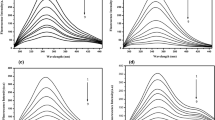Abstract
Purpose. The binding interactions of binedaline, nicardipine and darodipine with lipoproteins (HDL, LDL, VLDL) were examined as a function of pH in order to evaluate the role of lipoprotein components and ligand protonation in the binding process.
Methods. Binding studies were performed by equilibrium dialysis with radiolabeled ligands and differential UV-visible spectroscopy.
Results. Deprotonated ligands had a markedly higher affinity for lipoproteins than the protonated forms, resulting in a concomitant decrease in the pKa of bound ligands, i.e., a decrease in the basicity of the ligand in the bound state. The UV-visible difference spectra generated upon binding of auramine O to lipoproteins also showed that there was a contribution to the binding arising from the deprotonation of the ligand. Ligand binding was related to the phospholipid and cholesteryl ester content and to a lesser degree to the free cholesterol and protein content of lipoproteins, therefore to the surface monolayer components of lipoproteins. This relationship was even more accurate for the deprotonated, high-affinity, than for the protonated species.
Conclusions. It is suggested that among other possible interactions, ligand binding to lipoproteins involves proton exchange between the reactants and that the high affinity ligand species interact more specifically with the phospholipids of the lipoprotein surface monolayer.
Similar content being viewed by others
REFERENCES
J. P. Tillement, G. Houin, R. Zini, S. Urien, E. Albengres, J. Barré, M. Lecomte, P. D'Athis, and B. Sébille. Adv Drug Res 13:59–94 (1984).
J. C. Mazière, P. Morlière, and R. Santus. J Photochem Photobiol Biol 8:351–360 (1991).
S. Glasson, R. Zini, and J. P. Tillement. Biochem Pharmacol 31:831–835 (1982).
B. W. Shen, A. M. Scanu, and F. J. Kézdy. Proc Natl Acad Sci USA 74:837–841 (1977).
S. Urien, E. Albengres, R. Zini, and J. P. Tillement. Biochem Pharmacol 31:3687–89 (1982).
S. Urien, P. D'Athis, and J. P. Tillement. Biochem Pharmacol. 33:2283–89 (1984).
S. Urien, F. Brèe, B. Testa, and J. P. Tillement. Biochem J 280:277–280 (1991).
J. P. Corsetti, C. H. Weidner, J. Cianci, and C. E. Sparks. Anal Biochem 195:122–128 (1991).
L. A. Sklar, M. C. Doody, A. M. Gotto Jr, and H. J. Pownall. Biochemistry 19:1294–1301 (1980).
P. Greenspan and S. D. Fowler. J Lipid Res 26:781–789 (1985).
J. Y. C. Ma, J. K. H. Ma, and K. C. Weber. J Lipid Res 26:735–744 (1985).
R. Chelvi and C. D. Fitch. Antimicrob Agents Chemother 21:581–586 (1982).
G. A. Cutsforth, R. N. Whitaker, J. Hermans, and B. R. Lentz. Biochemistry 28:7453–7461 (1989).
Author information
Authors and Affiliations
Rights and permissions
About this article
Cite this article
Simon, N., Dailly, E., Jolliet, P. et al. pH Dependent Binding of Ligands to Serum Lipoproteins. Pharm Res 14, 527–532 (1997). https://doi.org/10.1023/A:1012120104615
Issue Date:
DOI: https://doi.org/10.1023/A:1012120104615




